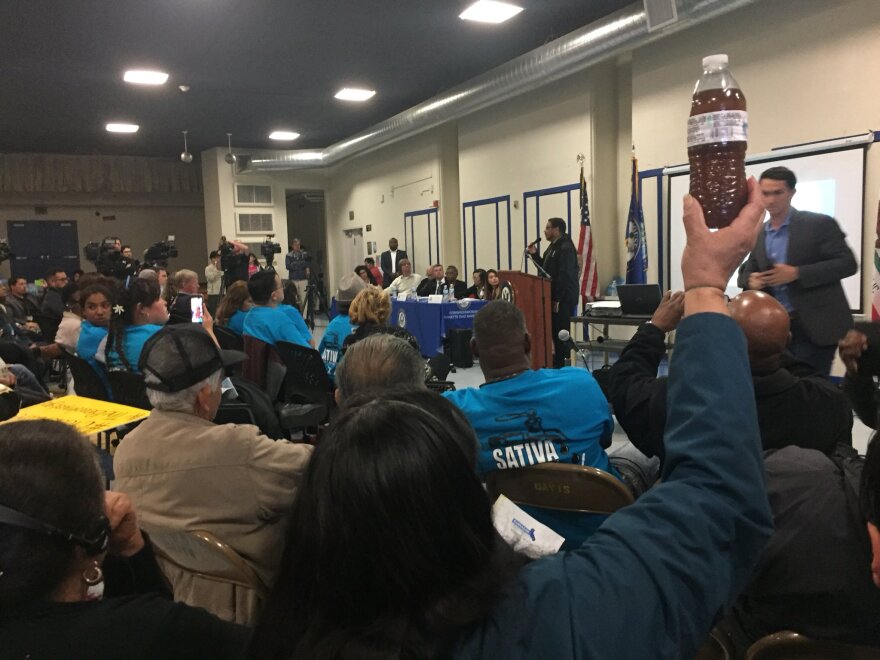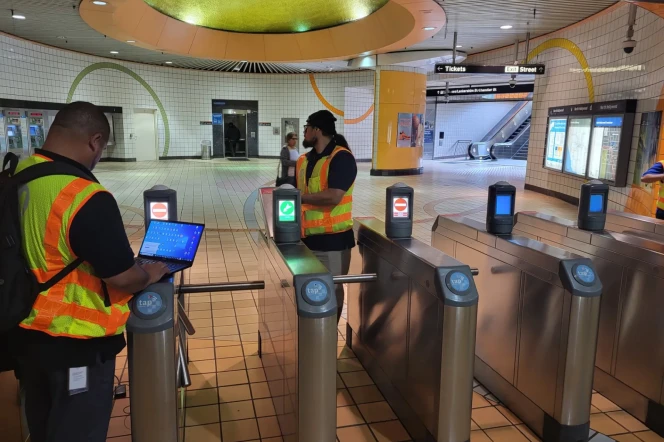With our free press under threat and federal funding for public media gone, your support matters more than ever. Help keep the LAist newsroom strong, become a monthly member or increase your support today.
Brown water is flowing from Compton faucets — and there's no quick fix

Lately, when Martha Barajas turns on her kitchen faucet, she braces herself for what's about to come out.
“Sometimes it’s brown. Sometimes it’s clear. Sometimes it’s a really thick, foggy white,” Barajas said. She's one of many Compton residents who've seen rusty-hued water flowing out of their taps in recent weeks. “We get surprises daily. I stopped drinking that water many months ago.”
The brown stuff is bubbling up in the Sativa Los Angeles County Water District, a nonprofit that delivers water to a small area of Compton and Willowbrook. They have a little over 1,600 customers, serving 6,800 people.
“One of my daughters got a rash because of the water,” said Alberto Hernandez. “Her skin is nothing but red. We need clean water.”
On Wednesday night, Hernandez and Barajas joined a few hundred community members packed into the cafeteria at George Washington Elementary School for a town hall meeting, hoping to get some answers about the murky water. Representative Nanette Barragán organized a panel of experts from state and local agencies to field questions.
The verdict? It looks unpleasant, but the State Water Resources Control Board said there is no risk from the foggy discoloration. The agency and the L.A. County Department of Public Health tested samples from homes in the area and all were well within a safe zone.
“Although it’s not a health concern, it’s certainly not acceptable,” said Jeff O’Keefe with the water board. “We are working with the utility and with other agencies to make sure this situation is resolved”
What's causing the murky water?
It’s happening because of a mineral — manganese — coming from the Sativa water district’s ground water source.
That mineral oxidizes easily and causes sedimentation to build up in the pipes. Those pipes have to be flushed once in a while to scour the sediments out.
It’s a common problem. That's why water districts open fire hydrants and increase water flow to flush out discolored buildup. Typically, customers see brown water for a few hours or a day. But the brown water in Compton and Willowbrook has been sticking around much longer—since mid-April.
An aging system
At the town hall, Sativa’s General Manager pointed the finger at the aging system.
“The biggest problem that we have is our infrastructure. It’s more than 70 years old.” Maria Garza said.
Upgrading won’t be cheap and Sativa serves a low-income customer base.
“We serve a disadvantaged community. We have one of the lowest water rates in this entire state, Garza said. “Our residents cannot afford a multi-million dollar project.”
They’ll likely need to find state grants to resolve the issue.
The issue isn't new. O’Keefe said a couple years ago, a water board investigation found Sativa had insufficient source capacity.
“We were hoping that they would have installed a new well since the time we wrote that report,” O’Keefe said. “However, that has not yet occurred.”
What's being done now?
The L.A. County Department of Public Health has been distributing bottled water to residents who don’t want to drink brown water. Earlier this week, county supervisors approved an emergency motion for what they’re calling a “strike team” to investigate the water quality.
A fix could involve installing more fire hydrants or new ground water wells to increase the flow, “so that the scour can be effective and get all the sedimentation out. We’re working with them to develop a plan,” O’Keefe said.
Hosting the town hall, Congresswoman Barragán pressed for answers about how long residents would have to wait until their water returned to normal.
Maria Garza said the majority of Sativa’s customers were not seeing brown water, but the problem isn’t resolved. “There are still sediments in our aging pipes,” Garza said. “And the only thing we can do is we either replace our pipes, or we continue with our maintenance flushing.”
“If your water is coming out brown, I want you to call my office,” Barragán told the audience. “If people are paying their water bill, they expect that the water coming out of the faucet isn’t going to be brown. In affluent neighborhoods like Beverly Hills and Malibu, they wouldn’t allow this to happen.”
South Los Angeles has seen other water quality scares in recent years. When murky water showed up in Watts in 2016 , the DWP blamed manganese and iron buildup due to water conservation efforts.
At the town hall in Compton, some neighbors said the problem extends beyond the Sativa water district.
“I have Compton water, and it’s been brown too,” said Joyce Kelly. “God only knows what’s in the water. It’s clear and it goes back to being dirty again.”







